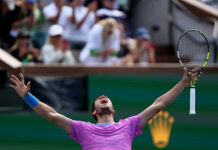Tales of War and Tennis From Pre-Communist China to Post-Communist Russia
By Bill Simons
Thirty years ago, Sportstyle magazine asked Jantzen executive Bart Blout, “In light of the events of 1984, what is your biggest concern for the sporting goods industry?” Blout replied, “Nuclear war. The rest is just a game.”
Since World War II, tennis’s four majors have been played 276 times and there have been almost 250 wars: little and large, civil and uncivil, secular and religious, hot and cold, just and far-from-just conflicts that have profoundly impacted many a soul; even sportspersons and tennis folks.
After all, in the Chinese Civil War, the first defining conflict after World War II, communist soldiers and even Mao Tse Tung himself played tennis. This was no accident. Sports and physical culture were critical in the emerging consciousness of the Chinese, who desperately wanted to reverse the demeaning view that they were “the sick men of Asia.” More than this, Mao adored table tennis, and by incredible coincidence, the President of the International Table Tennis Association was a passionate British communist. Well, connect the dots: After 24 years (and over 30 million deaths due to famine), in 1971, the Chinese very consciously used table tennis to orchestrate one of the most stunning diplomatic U-turns in history and break through China’s debilitating isolation. Never before or since has a sport had such a key diplomatic impact than when China reached out in ’71 to President Nixon’s Cold War America and initiated what has been called ping-pong diplomacy.
Of course, China’s extraordinary emergence onto the world stage was just one chapter in the 44-year old Cold War, which shaped the world at a time when tennis was essentially nonexistent behind the Iron Curtain. Sure, you can trace the history of Russia back to author Leo Tolstoy, who owned one of the first courts in the country. And there is a tennis scene in Anna Karenina. But so what? That bold, bouncing, bourgeois indulgence called tennis was a rarity among the gray and grim Soviet workers’ paradises of the East.
In 1955, while visiting London, the Soviet Union’s leader Nikita Khrushchev was asked, “Why don’t you have Russians in Wimbledon?” The dumbstruck fellow supposedly replied, “What’s Wimbledon?”
Yet a year later, Anna Dmitrieva, the first Soviet woman allowed to play outside the country, reached the finals of the Wimbledon juniors, and eventually America’s Ambassador to the UN, Andrew Young, would have weekly tennis games with Khrushchev’s former translator. But still, the Cold War essentially froze countless talents. There were some fabulous exceptions, like Jan Kodeš, Ilie Nastase, Ion Tiriac, Olga Morozova, Martina Navratilova, Ivan Lendl, and Monica Seles. More often, there were untapped abilities—a vast void.
Martina Navratilova explained, “You had players from East Germany who never got out. There was a player, Thomas Emmrich, who was one year older than me. There was no doubt in my mind he would have won a Grand Slam [title]. He was killing [Björn] Borg in the juniors.” As for Navratilova, her family was dispossessed by the Russians after World War II—reduced to living in a cramped, four-to-a-room apartment with no hot water and not much food. Still, Martina noted, “It was a life full of love in a country where women worked in the fields and factories alongside the men. There wasn’t anything wrong with sweating, or sports. That was healthy. What wasn’t was homosexuality … that was a sickness.” To make matters worse, Czech authorities controlled what tournaments she could play, limited her travel, and restricted her income. No wonder the teen dreamed of America, later writing, “This country was waiting for me.”
And so, with all the Cold War intrigue of a James Bond flick or a John le Carré novel, the scared-stiff 18-year-old Navratilova contacted the FBI and defected halfway through the ’75 US Open. It was all undercover. She didn’t even reveal her plans to her family or friends. In fact, her agent was convinced “somebody was going to stuff me in a taxi, jab me with a hypodermic needle, and hustle me onto an airplane bound for Czechoslovakia.”
When Martina defected, Czech authorities fumed, announcing, “Navratilova has suffered a defeat in the face of the Czechoslovak society. She had all possibilities in Czechoslovakia to develop her talent, but she preferred a professional career and a fat bank account.” It took half a decade for Navratilova to become a US citizen. She said this meant “five years of avoiding flights over Communist territory, just in case my plane would be forced to land and I would be taken off it.” As she put it, “I wasn’t taking any chances.”
———
The Cold War was a baffling patchwork of surreal realities. Alas, the gnawing question of whether we would all be reduced to radioactive dust seemed to hover, while high-stakes brinksmanship mixed with low-profile covert actions. Short-lived thaws were set against an imposing wall and a frightening missile crisis. Somber containment strategies like peaceful co-existence tried to counter the prevailing Dr. Strangelove mindset known as “mutually assured destruction.”
And there were hot killing fields too. For years, the world was preoccupied with the embattled rice paddies and explosive jungle trails of Vietnam. French colonialists had introduced tennis to the country, and as the Vietnam war escalated, America used tennis courts as jails and helicopter landing pads. Far from the rolling napalm, Saigon was home to a shady enclave—the Cercle Sportif club—where, according to promoters, “Sports, happiness, beauty … gathered in this privileged place, where a breeze of smiling good humor blows.” There, American ambassador Henry Cabot Lodge would swim, and Vietnamese and American generals alike played tennis on one of ten courts. Indeed, our most celebrated military leader, the chiseled General William Westmoreland, suffered his only injury of the war when he broke his wrist in a fall while playing tennis at the club.
But everyone knew “‘Nam”—where we somehow found ourselves destroying villages in order to save them—was all about contradictions. So Bud Collins noted that when rebel protestor Abbie Hoffman was on the Brandeis College tennis team that he coached, the rowdy radical played a very conservative baseline game. Vietnam—where it’s said 3.8 million people perished—was far more violent than a broken wrist. Arthur Ashe’s brother, Johnnie, famously re-enlisted for an extra tour of duty in the Army, so Arthur—a bound-for-stardom Army lieutenant working at West Point in data processing—could avoid combat.
There were tennis goodwill tours to Vietnam by Ashe (who was criticized for not speaking out against the war), Stan Smith, Donald Dell, and Collins, who was also a war correspondent going on patrols with the Marines and bombing missions with the Air Force. Collins and many others came away with cautionary views. Dell eventually worked for Bobby Kennedy’s anti-war Presidential campaign.
The fallout from Vietnam lingered for decades. Collins later claimed that we suffered from a kind of national amnesia, that subsequent wars proved we had learned little from our Vietnam experience. Over 4,000 courts were built in Vietnam after the war, and the ATP eventually staged a short-lived Vietnam Open. The once-exclusive Cercle Sportif club now draws thousands, who pay a 75-cent entry fee to enjoy the place. And then there is the inevitable McEnroe connection. As Mac came under scrutiny in the ’80s, analyst John Yandell remarked, “McEnroe’s emotional nature has always made him an easy target in the tennis press, which is governed by the same stiff-upper-lip, elitist white mentality which gave us, among other achievements, the welfare state and the Vietnam War.” Ouch.
———
As the Cold War began to thaw, so did the Soviet Union’s aversion to tennis. Pam Shriver and the feisty Belarus native Natasha Zvereva (who reached the ’88 French Open final) formed a symbolic doubles duo, tennis’ equivalent of Gorbachev and Reagan. More to the point, Zvereva brazenly displayed her runner-up check of $24,000 at the Family Circle Cup and defiantly declared, “This is not money, it is paper. I want my money.” Soon, Russian players were able to keep their winnings and control their careers.
The Olympics encouraged both the Soviet government and its citizens to give the game a shot. Eventually, it paid off. Yevgeny Kafelnikov won Slams in ’96 and ’99, Marat Safin (who is now in the Russian Duma) won the US Open in 2000, and Anna Kournikova emerged from a basement apartment to become a kind of anti-babushka—a sashaying sex-pot who endorsed bras on London billboards, relished her swanky Miami digs, and countered the image of a somber Soviet lady under the thumb of the machine.
Frank Deford observed that Kournikova looked “like a trim sloop, skimming across the surface, her long signature pigtail flying about like a torn spinnaker in the wind. Her lines are perfect—especially now that she doesn’t jam the second-service ball up her knickers.” But Anna was no airhead. While these days Maria Sharapova is more-than-reticent to speak up for gay rights in Russia, Kournikova, the supposed bimbo, let ‘err rip. “The only thing I’m concerned about is war.” she said. “There is enough space for everyone in the world. Why can’t they talk—not with tanks and guns? Why did they send those Russian kids to die in Afghanistan? They didn’t even live yet. How many mothers are crying out there? There’s not even a cemetery there for their bones.”
Maybe it shouldn’t have shocked us that in post-Soviet Russia, when the drone of timelessness was finally silenced, tennis began to thrive. After all, as writer Sandra McKee told us, “Find a sport that requires grace, single-mindedness and robot-like dedication to training and practice, then set a Russian to the task, and, most of the time, you’ll find a champion.” Plus, Russia’s first post-Soviet leader, Boris Yeltsin, was a committed tennis nut who pushed the game big time. Never mind that many of his nation’s best players—Kournikova, Sharapova, Petrova, Tursunov—fled to America. Russians still crowded the rankings. In 2004, they had five top players in the WTA top 10 and won three of the women’s majors. Never had a nation emerged with such speed and might. It inspired many a quip, such as Serena saying, “I have to play one of those ‘ovas’ in the next round, I’m just not sure which one.” One Russia-watcher added, “You’ve come a long way, Svetlana.” The Russians were no longer coming. They were here.
Over the years, the Cold War had left its mark, and its demise changed the game. In a poignant counterpoint to the cliché “You can never go home again,” Navratilova made a triumphant return in ’86 to Czechoslovakia as a member of the US Fed Cup team. For 11 years she had been persona non-grata in her homeland. Now, wrote Frank Deford, “It almost seemed like the Statue of Liberty was on tour.” On a court with a ponderous Soviet-era sign—”Sport Helps Peaceful Understanding Among Nations”—men ran out to give her roses. Linesmen demanded her autograph. A railroad engineer drove his train back and forth just to see Martina play, and one Czech doctor explained why he was rooting for the American: “Martina has freedom, and we do not. How else can I let the bastards know?”
In ’59, Vice-President Nixon famously pitched the American Dream to Nikita Khrushchev in the iconic Cold War “Kitchen Debate.” Standing in a model suburban home at the American Exhibition in Moscow, Nixon showcased the merits of American consumerism. Years later, Russia’s Nadia Petrova moved to the US and said she wanted to live the rest of her life here because of the weather and way of life. As if to echo Nixon, she said, “[If] you need to go to the drug store, it’s open 24 hours. Everything is here just for the people .. I don’t have to stress. I don’t have that crazy traffic like in Russia. I don’t have those cold winters. I just feel comfortable here.”
At her induction into the International Tennis Hall of Fame last year, Czech-born Martina Hingis said, “I was born behind the Iron Curtain, and my mother wanted to tear the curtain apart for me. That’s the reason I played tennis as a little girl. My mother didn’t have many choices for giving me a better life or for freedom … She chose tennis as a way out of the prison we lived in.” Moments later, Hingis lobbed up an ill-timed, gratuitous capitalist plug for her apparel sponsor.
Perhaps more than any other endeavor, tennis has created a kind of post-Cold War bridge filled with characters: a cadre of fusion-figures—like the Martinas (Navratilova and Hingis), Maria Sharapova, Anna Kournikova, Monica Seles, Novak Djokovic, and Ana Ivanovic—who emerged out of Eastern Bloc cultures, but whose lives and personalities have been crafted by the West.
___
After the fall of the Berlin Wall in 1989, West German Steffi Graf ventured east to Leipzig to win the first tournament in the newly-united Germany. Tears flowed, while on a broader scale, the end of the Cold War spurred a brief flurry of euphoria. It wasn’t like World War I, which was justified as “the war to end all wars.” Still, there was a window of opportunity. Dreamers imagined that just maybe, with the end of the Soviet Bloc, an idyllic world might emerge and world peace might break out.
Think again.
In 1990, during America’s invasion of Kuwait and subsequent surge to Baghdad, as the patriotic drumbeat of war sounded loud, Andre Agassi said if he was called to fight he would be “the first one on the plane.” Bob Kramer, then the head of the Southern California Tennis Association, joined his Air National Guard Unit in Britain. American Scott Davis and Austrian Alex Antonitsch taunted each other and got into a scuffle due to their differing views on the war. Perhaps because there were such hopes for peace, when war once again did come, many voices of dissent were heard. As yet another round of violence broke out, journalist Herb Caen rendered a stark contrast: while some enjoyed a joyous game of tennis in Mill Valley, halfway across the world, our nation was dropping bombs. The bliss of our sunny weekend games was so distant from the pounding violence, the fog of war.
Tournaments from Casablanca to Martinique were suspended, along with eight Davis Cup ties. Many spoke out. “What does it matter how you hit a backhand now that the war has started,” said Stefan Edberg. Similarly, Monica Seles contended, “It’s hard to concentrate on something as small as tennis when people are out there suffering.” Aussie Open champ Boris Becker was reticent to express his views during the awards ceremony in Melbourne. But he later confided, “I will always regret that I didn’t [speak out]. The next morning I read that they had bombed Baghdad again … I couldn’t stop thinking that hundreds, maybe thousands of people were dying while I was warming up for a tennis match. That’s insane.”
Many might agree, Boris. After all, as writer R.G. Risch noted, “War is nothing but organized insanity.”



















